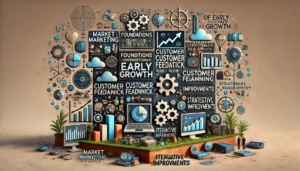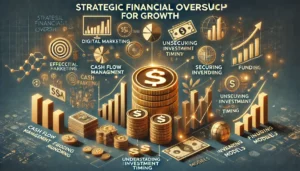Sustainable Scaling: Mastering Growth Without Compromising ROI

Mastering Growth Without Compromising ROI: Growing a business is exciting but can be tricky. You want to get bigger without wasting money. This article will show you how to grow smartly and keep your profits healthy. We’ll talk about the challenges of growing, the important numbers to watch, and the best ways to keep your business strong.
Key Takeaways
- Understanding the balance between growth and return on investment (ROI) is crucial for sustainable success.
- Key metrics like Customer Acquisition Cost (CAC) and Lifetime Value (LTV) help in measuring growth effectively.
- Effective strategies include optimising how you get and keep customers, and making your operations more efficient.
- Scaling your marketing and sales efforts can drive growth, but they need to be aligned and scalable.
- Financial management, including budgeting and forecasting, is essential to support sustainable growth.
Understanding the Growth Paradox
Balancing Expansion and ROI
Sustainable expansion isn’t about growing at all costs; it’s about growing without compromising stability. Strive to maintain a healthy balance between growth ambitions and financial prudence. Rapid and unchecked expansion can lead to overextension, impacting cash flow and overall stability. Remember, the goal is to achieve growth while preserving financial health.
Common Pitfalls in Rapid Scaling
In today’s fast-paced business landscape, the temptation to achieve rapid expansion is strong. With new markets, technologies, and opportunities on the horizon, entrepreneurs often find themselves sprinting towards growth targets. However, it’s important to remember that unbridled expansion can bring unforeseen challenges that jeopardise the very foundation of your business.
Long-term vs. Short-term Gains
Early growth is not an overnight phenomenon. It stems from a combination of market research, customer feedback, strategic planning, and iterative improvements. Understanding the nuances of this phase can make the difference between a start up that merely survives and one that thrives.
Key Metrics for Sustainable Growth
To achieve sustainable growth, you need to focus on specific metrics that help you measure success and make informed decisions. Defining clear metrics is essential for tracking both short-term achievements and long-term goals. Here are some key metrics to consider:
Customer Acquisition Cost (CAC)
Customer Acquisition Cost (CAC) is the total cost of acquiring a new customer. This includes marketing expenses, sales costs, and any other related expenses. Keeping CAC low is crucial for maintaining a healthy ROI. To calculate CAC, divide the total acquisition costs by the number of new customers acquired during a specific period.
Lifetime Value (LTV)
Lifetime Value (LTV) measures the total revenue a business can expect from a single customer account. A higher LTV indicates that customers are more valuable over time. To calculate LTV, multiply the average purchase value by the number of purchases per year and the average customer lifespan.
Churn Rate and Retention
Churn rate is the percentage of customers who stop using your product or service during a given period. A high churn rate can be a red flag, indicating that customers are not satisfied. On the other hand, retention rate measures the percentage of customers who continue to use your product or service. Improving retention is often more cost-effective than acquiring new customers.
Monitoring these metrics will help you identify areas for improvement and make data-driven decisions to optimise growth.
Effective Strategies for Mastering Growth Without Compromising ROI
Optimising Customer Acquisition
To grow sustainably, you need to focus on acquiring customers efficiently. Identify your target audience and tailor your marketing efforts to reach them. Use data analytics to understand customer behaviour and preferences. This will help you create personalised marketing campaigns that resonate with your audience. Additionally, leverage social media and SEO to increase your visibility and attract more potential customers.
Enhancing Customer Retention
Keeping your existing customers is just as important as acquiring new ones. Implement loyalty programs and offer excellent customer service to keep your customers coming back. Regularly engage with your customers through email newsletters and social media to keep them informed about new products and promotions. Remember, happy customers are more likely to refer your business to others.
Improving Operational Efficiency
Streamlining your operations can significantly impact your bottom line. Automate repetitive tasks to save time and reduce errors. Invest in technology that enhances productivity and allows your team to focus on more strategic activities. Regularly review your processes and look for areas where you can cut costs without compromising quality.
Sustainable growth is not just about expanding your customer base but also about optimising your operations and retaining your existing customers. By focusing on these areas, you can build a strong foundation for long-term success.
Scaling Marketing and Sales Efforts
Leveraging Digital Marketing
To scale your marketing efforts, start by leveraging digital marketing channels. Google ads PPC and other online advertising platforms can help you reach a larger audience efficiently. Consider working with a PPC agency or a specialised London PPC agency to optimise your campaigns. These agencies can provide valuable insights and manage your ads effectively. Additionally, conducting a thorough Google ads audit can identify areas for improvement and ensure your budget is well-spent.
Building a Scalable Sales Team
Building a scalable sales team involves more than just hiring more salespeople. Focus on training and development to ensure your team can handle increased demand. Implementing sales enablement tools can streamline processes and improve productivity. Align your sales strategies with your overall business goals to ensure consistency and effectiveness.
Aligning Sales and Marketing Goals
Aligning sales and marketing goals is crucial for sustainable growth. Encourage collaboration between your sales and marketing teams by setting shared objectives and key performance indicators (KPIs). Regular meetings and data sharing can foster a unified approach, leading to better results. Measure success through metrics like sales revenue, lead generation, and ROI to ensure both teams are working towards the same goals.
Scaling your marketing and sales efforts requires a strategic approach, leveraging technology, and fostering collaboration between teams. By focusing on these areas, you can achieve sustainable growth without compromising your ROI.
Financial Management and Forecasting
Budgeting for Growth
Strategic financial oversight is essential for growth. Effective allocation of funds, cash flow management, and securing funding are critical to supporting growth initiatives. Being financially savvy involves understanding when and where to invest, ensuring you have enough runway, and preparing detailed financial models that highlight future scalability and profitability.
Cash Flow Management
Financial engineering is about finding the right mix of funding options to fuel growth while managing the associated risks. It’s a balancing act that requires careful consideration of the company’s current financial health, future projections, and the economic environment. By leveraging a variety of financial instruments and strategies, businesses can secure the capital they need to scale effectively and sustainably.
Financial Forecasting Tools
Growth requires strategic financial oversight. Effective allocation of funds, cash flow management, and securing funding are critical to supporting growth initiatives. Being financially savvy involves understanding when and where to invest, ensuring you have enough runway, and preparing detailed financial models that highlight future scalability and profitability.
Cultivating a Scalable Company Culture
Maintaining Core Values
When scaling, it’s crucial to keep your company’s core values intact. These values are the foundation of your culture and guide every decision. Consistency in values helps in maintaining trust and alignment among employees. Make sure to communicate these values clearly and often.
Employee Engagement Strategies
Engaged employees are more productive and loyal. To foster engagement, create an environment where feedback is encouraged and valued. Regularly recognise and reward contributions. Consider implementing programs that promote work-life balance and professional growth.
Leadership and Vision
Strong leadership is essential for scaling. Leaders should embody the company’s values and vision, setting an example for others. They need to be transparent, approachable, and supportive. A clear vision helps in aligning the team’s efforts towards common goals.
Scaling a company without losing its culture requires a delicate balance of maintaining core values, engaging employees, and strong leadership. It’s not just about growth, but sustainable growth that benefits everyone involved.
Real-world Case Studies
When it comes to mastering growth without compromising ROI, real-world examples can be incredibly insightful. In this section, we will explore various case studies that highlight both successes and failures in scaling businesses sustainably. These examples will provide you with practical lessons and strategies that you can apply to your own growth journey.
Conclusion
In the journey of scaling your business, it’s crucial to balance growth with maintaining a healthy return on investment (ROI). By focusing on key metrics, implementing sustainable strategies, and fostering a strong company culture, you can achieve long-term success without sacrificing profitability. Remember, growth should not come at the expense of efficiency or customer satisfaction. With careful planning and execution, your business can expand smartly and sustainably. Keep these principles in mind, and you’ll be well on your way to mastering growth without compromising ROI.
Frequently Asked Questions
What is the growth paradox?
The growth paradox is the challenge of expanding a business while maintaining a good return on investment (ROI). It means growing without spending too much or losing quality.
Why is it important to balance short-term and long-term gains?
Balancing short-term and long-term gains is crucial because focusing only on quick wins can hurt your business in the future. Long-term planning helps ensure lasting success.
What is Customer Acquisition Cost (CAC)?
Customer Acquisition Cost (CAC) is the amount of money you spend to get a new customer. This includes marketing, sales, and other expenses.
How can I improve customer retention?
You can improve customer retention by offering great customer service, rewarding loyal customers, and regularly engaging with them through emails or social media.
What are some common pitfalls in rapid scaling?
Common pitfalls in rapid scaling include overspending, losing focus on quality, neglecting customer needs, and not having a solid plan for growth.
Why is company culture important when scaling?
Company culture is important because it keeps your team motivated and aligned with your business goals. A strong culture helps maintain quality and performance as you grow.
Author
Search Blog
Free PPC Audit
Subscribe to our Newsletter
The Voices of Our Success: Your Words, Our Pride
Don't just take our word for it. With over 100+ five-star reviews, we let our work-and our satisfied clients-speak for us.
"We have been working with PPC Geeks for around 6 months and have found Mark and the team to be very impressive. Having worked with a few companies in this and similar sectors, I rate PPC Geeks as the strongest I have come across. They have taken time to understand our business, our market and competitors and supported us to devise a strategy to generate business. I value the expertise Mark and his team provide and trust them to make the best recommendations for the long-term."
~ Just Go, Alasdair Anderson




